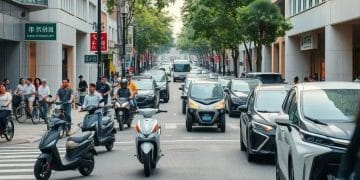AI-driven traffic congestion management systems revolutionize cities

AI-driven traffic congestion management systems utilize artificial intelligence to analyze real-time data, optimizing traffic flow, enhancing safety, and reducing congestion in urban environments.
AI-driven traffic congestion management systems are changing how cities tackle their worst traffic problems. Imagine smoother commutes and less frustration during rush hour. Ready to dive deeper into this transformative technology?
Understanding AI in traffic management
Understanding AI in traffic management is essential for improving how cities handle vehicular flow. These systems transform raw traffic data into actionable insights. A deeper knowledge of AI capabilities can lead to better urban planning and a smoother commuting experience.
How AI Works in Traffic Management
AI-driven systems can analyze large amounts of traffic data quickly and efficiently. They use algorithms to predict traffic patterns based on various factors, such as time of day and weather conditions. By processing real-time data, these systems can adjust traffic signals to optimize flow.
Benefits of Using AI in Traffic Management
Implementing AI in traffic systems presents numerous advantages. These include:
- Reduced congestion and improved travel times.
- Enhanced safety measures and accident predictions.
- Energy efficiency by minimizing stop-and-go traffic.
- Better resource allocation for public transportation.
Additionally, AI-driven traffic management can enhance communication between vehicles and traffic signals. This enables smoother merges and more efficient highway entries. As cities continue to grow, the importance of integrating AI becomes increasingly clear.
Challenges in Implementing AI
Despite its benefits, there are challenges in adopting AI solutions. These can include high costs and the need for infrastructure upgrades. Furthermore, data privacy concerns arise when collecting vast amounts of traffic data. Addressing these challenges is crucial for successful implementation.
In conclusion, understanding AI in traffic management opens new avenues for innovation in our urban environments. By embracing these technologies, cities can foster safer, more efficient roads for everyone.
Key benefits of AI-driven systems

The key benefits of AI-driven systems in traffic management significantly enhance urban mobility. These systems utilize data to create smarter solutions for everyday traffic issues. By analyzing patterns, they help cities make informed decisions about traffic flow.
Improved Traffic Flow
One of the most notable benefits is the improvement of traffic flow. AI-driven systems can adjust traffic lights based on real-time data, reducing wait times at intersections. This leads to less congestion and a smoother travel experience for commuters.
Enhanced Safety
Another advantage is enhanced safety on the roads. AI can predict potential accidents by analyzing traffic trends. With this information, cities can implement safety measures where they are needed most.
- Real-time updates on traffic incidents.
- Smart pedestrian crossings to ensure safety.
- Accident prediction through data analysis.
Additionally, the integration of AI helps in making public transportation more efficient. Buses and trains can be scheduled more effectively, providing better service to passengers.
Energy Efficiency
AI-driven systems also promote energy savings. By optimizing traffic flow, these systems minimize fuel consumption and reduce emissions. This not only benefits the environment but also saves money on fuel costs.
As cities continue to grow, leveraging the power of AI systems becomes essential for sustainable urban development. With the right technologies, communities can enjoy more efficient and safer roadways.
Challenges of implementing AI in traffic solutions
Implementing AI in traffic solutions presents several challenges. These hurdles can affect how quickly cities adopt new technologies. Understanding these obstacles is crucial for successful integration of AI-driven systems.
High Costs
One significant challenge is the high costs associated with AI technologies. Initial investments can be substantial, especially when upgrading existing infrastructure. Cities must budget effectively to cover software, hardware, and training expenses.
Data Privacy Concerns
Another challenge involves data privacy. Collecting and analyzing traffic data can lead to concerns about how personal information is handled. Citizens may feel uneasy about being monitored, making transparency crucial when implementing AI-driven systems.
- Ensuring security of data collected from users.
- Compliance with local and national regulations.
- Building trust with the public regarding data usage.
Moreover, the integration of AI technology requires skilled professionals. There is a demand for data scientists and engineers who understand both traffic management and AI. This talent shortage can slow down adoption in many regions.
Technical Challenges
Technical difficulties in integrating various systems also pose challenges. Existing traffic management systems may not easily connect with new AI-driven solutions. Addressing compatibility issues is essential for seamless operation.
Despite these hurdles, the potential benefits of AI in traffic management encourage cities to work through these challenges. By focusing on solutions, communities can embrace innovation that enhances safety and efficiency on the roads.
Future trends in traffic congestion management

Looking ahead, future trends in traffic congestion management are set to transform the way cities operate. These advancements promise to enhance mobility and improve urban life. By integrating new technologies, cities can build smarter, more efficient traffic systems.
Integration of Smart Technologies
One significant trend is the continued integration of smart technologies. AI-driven systems will become even more advanced, utilizing real-time data to optimize traffic flow. As more vehicles become connected, communication between cars and traffic systems will allow for better management of road usage.
Predictive Analytics
Another important trend is the rise of predictive analytics. By analyzing patterns and trends in traffic data, cities will be able to predict congestion before it occurs. This proactive approach allows for timely adjustments to traffic signals and routing, minimizing delays.
- Use of historical traffic data to forecast congestion.
- AI algorithms to analyze real-time conditions.
- Dynamic traffic routing to reduce congestion.
Additionally, the importance of sustainability is influencing future trends. Cities are increasingly focused on reducing their carbon footprints. This has led to the integration of more efficient public transportation options and the promotion of cycling and walking paths to alleviate congestion.
Enhanced Public Engagement
Future traffic management systems will also prioritize public engagement. Residents will have access to applications that provide real-time updates on traffic conditions. This transparency empowers citizens to make informed decisions about their commutes, contributing to smoother traffic flow.
As these trends continue to evolve, cities that embrace AI-driven traffic solutions will lead the way in creating more livable environments for their residents. The focus on technology, sustainability, and community involvement will pave the way for the future of urban mobility.
FAQ – Frequently Asked Questions about AI-driven Traffic Management Systems
What are AI-driven traffic management systems?
AI-driven traffic management systems use artificial intelligence to analyze traffic data in real-time, optimizing traffic flow and reducing congestion.
How can AI improve road safety?
AI can predict and identify potential traffic incidents by analyzing patterns, enabling cities to implement safety measures and reduce accidents.
What challenges do cities face in implementing AI technology?
Cities often encounter high costs, data privacy concerns, and technical difficulties when integrating AI into existing traffic management systems.
What future trends should we expect in traffic management?
Future trends include the integration of smart technologies, predictive analytics, and enhanced public engagement, all aimed at improving urban mobility.





